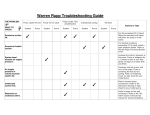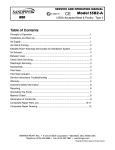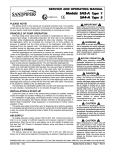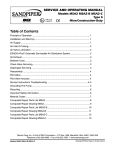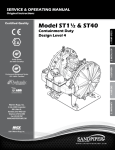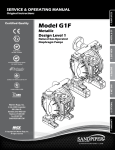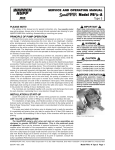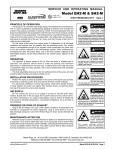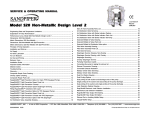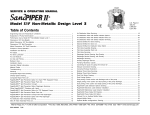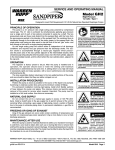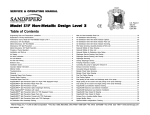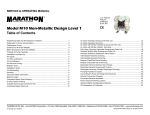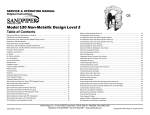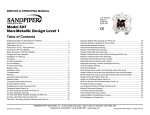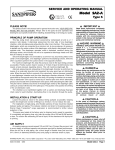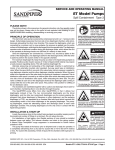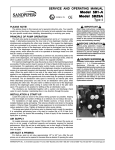Download PDF
Transcript
SERVICE and OPERATING MANUAL II 2GD T5 Model SSA2-A Type 4 Table of Contents Principle of Operation............................................................................................. 1 Installation and Start-Up......................................................................................... 1 Air Supply............................................................................................................... 1 Air Inlet & Priming................................................................................................... 2 ESADS+Plus®: Externally Serviceable Air Distribution System................................. 2 Air Exhaust............................................................................................................. 3 Between Uses........................................................................................................ 3 Check Valve Servicing............................................................................................ 3 Diaphragm Servicing.............................................................................................. 3 Reassembly............................................................................................................ 3 Pilot Valve............................................................................................................... 4 Pilot Valve Actuator................................................................................................. 4 Service Instructions: Troubleshooting .................................................................... 5 Warranty................................................................................................................. 5 Important Safety Information.................................................................................. 6 Recycling................................................................................................................ 6 Grounding The Pump............................................................................................. 7 Material Codes....................................................................................................... 8 Declaration of Conformity....................................................................................... 9 Composite Repair Parts List............................................................................10-11 Composite Repair Drawing................................................................................... 12 WARREN RUPP, INC. • A Unit of IDEX Corporation • Mansfield, Ohio 4492 Telephone (419) 524-8388 • Fax (419) 522-7867 • warrenrupp.com ©Copyright 2014 IDEX AODD, Inc. All rights reserved. SERVICE and OPERATING MANUAL II 2GD T5 Model SSA2-A Type 4 PRINCIPLE OF PUMP OPERATION This flap swing check valve pump is powered by compressed air and is a 1:1 pressure ratio design. It alternately pressurizes the inner side of one diaphragm chamber, while simultaneously exhausting the other inner chamber. This causes the diaphragms, which are connected by a common rod, to move endwise. Air pressure is applied over the entire surface of the diaphragm, while liquid is discharged from the opposite side. The diaphragm operates under a balanced condition during the discharge stroke, which allows the unit to be operated at discharge heads over 200 feet (61 meters) of water head. Since the diaphragms are connected by a common rod, secured by plates to the center of the diaphragms, one diaphragm performs the discharge stroke, while the other is pulled to perform the suction stroke in the opposite chamber. For maximum diaphragm life, keep the pump as close to the liquid being pumped as possible. Positive suction head in excess of 10 feet of liquid (3.048 meters) may require a back pressure regulating device. This will maximize diaphragm life. Alternate pressuring and exhausting of the diaphragm chamber is performed by means of an externally mounted, pilot operated, four-way spool type air distribution valve. When the spool shifts to one end of the valve body, inlet air pressure is applied to one diaphragm chamber and the other diaphragm chamber exhausts. When the spool shifts to the opposite end of the valve body, the porting of chambers is reversed. The air distribution valve spool is moved by an internal pilot valve which alternately pressurizes one side of the air distribution valve spool, while exhausting the other side. The pilot valve is shifted at each end of the diaphragm stroke by the diaphragm plate coming in contact with the end of the pilot spool. This pushes it into position for shifting of the air distribution valve. The chambers are manifolded together with a suction and discharge flap-type check valve for each chamber, maintaining flow in one direction through the pump. INSTALLATION & START-UP Locate the pump as close to the product being pumped as possible, keeping suction line length and number of fittings to a minimum. Do not reduce line size. For installations of rigid piping, short flexible sections of hose should be installed between pump and piping. This reduces vibration and strain to the piping system. A Warren Rupp Tranquilizer® surge suppressor is recommended to further reduce pulsation in flow. This pump was tested at the factory prior to shipment and is ready for operation. It is completely self-priming from a dry start for suction lifts of 20 feet (6.096 meters) or less. For suction lifts exceeding 20 feet of liquid, fill the chambers with liquid prior to priming. AIR SUPPLY Air supply pressures cannot exceed 125 psi (8.61 bar). Connect the pump air inlet to an air supply of sufficient capacity and pressure required for desired performance. When the air line is solid piping, use a short length of flexible hose [not less than 3/4" (19mm) in diameter] between pump and piping to eliminate strain to pipes. ssa2dl4sm-REV0614 Model SSA2-A Page 1 AIR INLET & PRIMING For start-up, open an air valve approximately 1/2 to 3/4 turn. After the unit primes, an air valve can be opened to increase flow as desired. If opening the valve increases cycling rate, but does not increase flow rate, cavitation has occurred, and the valve should be closed slightly. For the most efficient use of compressed air and the longest diaphragm life, throttle the air inlet to the lowest cycling rate that does not reduce flow. A NOTE ABOUT AIR VALVE LUBRICATION The SandPiper pump’s pilot valve and main air valve assemblies are designed to operate WITHOUT lubrication. This is the preferred mode of operation.There may be instances of personal preference, or poor quality air supplies when lubrication of the compressed air supply is required. The pump air system will operate with properly lubricated compressed air supplies. Proper lubrication of the compressed air supply would entail the use of an air line lubricator (available from Warren Rupp) set to deliver one drop of 10 wt., non-detergent oil for every 20 SCFM of air the pump consumed at its point of operation. Consult the pump’s published Performance Curve to determine this. It is important to remember to inspect the sleeve and spool set routinely. It should move back and forth freely. This is most important when the air supply is lubricated. If a lubricator is used, oil accumulation will, over time, collect any debris from the compressed air. This can prevent the pump from operating properly. Water in the compressed air supply can create problems such as icing or freezing of the exhaust air causing the pump to cycle erratically, or stop operating. This can be addressed by using a point of use air dryer to supplement a plant’s air drying equipment. This device will remove excess water from the compressed air supply and alleviate the icing or freezing problem. ESADS: EXTERNALLY SERVICEABLE AIR DISTRIBUTION SYSTEM Please refer to the exploded view drawing and parts list in the Service Manual supplied with your pump. If you need replacement or additional copies, contact your local Warren Rupp Distributor, or the Warren Rupp factory Literature Department at the number shown below. To receive the correct manual, you must specify the MODEL and TYPE information found on the name plate of the pump. The main air valve sleeve and spool set is located in the valve body mounted on the pump with four hex head capscrews. The valve body assembly is removed from the pump by removing these four hex head capscrews. With the valve body assembly off the pump, access to the sleeve and spool set is made by removing four hex head capscrews (each end) on the end caps of the valve body assembly. With the end caps removed, slide the spool back and forth in the sleeve. The spool is closely sized to the sleeve and must move freely to allow for proper pump operation. An accumulation of oil, dirt or other contaminants from the pump’s air supply, or from a failed diaphragm, may prevent the spool from moving freely. This can cause the spool to stick in a position that prevents the pump from operating. If this is the case, the sleeve and spool set should be removed from the valve body for cleaning and further inspection. Remove the spool from the sleeve. Using an arbor press or bench vise (with an improvised mandrel), press the sleeve from the valve body. Take care not to damage the sleeve. At this point, inspect the o-rings on the sleeve for nicks, tears or abrasions. Damage of this sort could happen during assembly or servicing. A sheared or cut oring can allow the pump’s compressed air supply to leak or bypass within the air valve assembly, causing the pump to leak compressed air from the pump air exhaust or not cycle properly. This is most noticeable at pump dead head or high discharge pressure conditions. Replace any of these o-rings as required or set up a routine, preventive maintenance schedule to do so on a regular basis. This practice should include cleaning the spool and sleeve components with a safety solvent or equivalent, inspecting for signs of wear or damage, and replacing worn components. To re-install the sleeve and spool set, lightly lubricate the o-rings on the sleeve with an o-ring assembly lubricant or lightweight oil (such as 10 wt. air line lubricant). Re-install one end cap, gasket and bumper on the valve body. Using the arbor press or bench vise that was used in disassembly, carefully press the sleeve back into the valve body, without shearing the o-rings. You may have to clean the surfaces of the Model SSA2-A Page 2 ssa2dl4sm-REV0614 valve body where the end caps mount. Material may remain from the old gasket. Old material not cleaned from this area may cause air leakage after reassembly. Take care that the bumper stays in place allowing the sleeve to press in all the way. Reinstall the spool, opposite end cap, gasket and bumper on the valve body. After inspecting and cleaning the gasket surfaces on the valve body and intermediate, reinstall the valve body on the pump using new gaskets. Tighten the four hex head capscrews evenly and in an alternating cross pattern. AIR EXHAUST If a diaphragm fails, the pumped liquid or fumes can enter the air end of the pump, and be exhausted into the atmosphere. When pumping hazardous or toxic materials, pipe the exhaust to an appropriate area for safe disposition. This pump can be submerged if materials of construction are compatible with the liquid. The air exhaust must be piped above the liquid level. Piping used for the air exhaust must not be smaller than 1" (2.54 cm). Reducing the pipe size will restrict air flow and reduce pump performance .When the product source is at a higher level than the pump (flooded suction), pipe the exhaust higher than the product source to prevent siphoning spills. Freezing or icing-up of the air exhaust can occur under certain temperature and humidity conditions. Use of an air dryer unit should eliminate most icing problems. BETWEEN USES When used for materials that tend to settle out or transform to solid form, the pump should be completely flushed after each use, to prevent damage. Product remaining in the pump between uses could dry out or settle out. This could cause problems with valves and diaphragms at re-start. In freezing temperatures, the pump must be drained between uses in all cases. CHECK VALVE SERVICING Valve inspection requires removal of the ten hand knobs around the outer chamber. Once the knobs have been removed the outer chamber can be pulled away exposing the flap valves and valve seats. Visual inspection and removal is possible. The flap valve should be free to swing on the valve seat. Any obstrucion should be removed. The opposite side check valves can be inspected by following same procedure. The flap valve can be disassembled by removing the seal retainer. This makes it possible to inspect the seal ring, retainer and flap valve. Upon reassembly, torque the retainer (item 28-3) into the flap valve (item 28-1) to a maximum of 43 ft/lbs. (58.30 Newton meters). DIAPHRAGM SERVICING To inspect or remove a diaphragm the ten hand knobs around the chamber flange must be backed off. Pulling the outer chamber away exposes the diaphragm. Use care to keep foreign matter from behind the diaphragm. The opposite diaphragm may be inspected by the same procedure. To remove diaphragms, hold the diaphragm plate opposite to the diaphragm you wish to remove. Unthread the outer plate on the diaphragm being replaced. Once plate is removed, the diaphragm assembly will pull out of the bracket. Now the shaft, shaft seal, and pilot valve actuator bushings are easily inspected. REASSEMBLY All procedures for reassembling the pump are the reverse of the previous instructions with further instructions as shown: 1. Attach an -030- diaphragm to one end of the pump's diaphragm rod (685-033120) utilizing the threads of the outer diaphragm plate (612-197-111). The natural sequence of parts in the assembly is outer diaphragm plate, diaphragm and inner diaphragm plate. Tighten the assembly by hand. Install the diaphragm bumper (132-002-360) on the diaphragm rod and install the assembly into the pump. Attach the pump's outer chamber to this side, securing it in place with the fasteners. Install the second diaphragm and its components to the opposite side of the pump in the same sequence. Tighten the assembly to a torque value of 40 ft. lbs. (54.23 Newton meters). You can finish the pump assembly at this point after any additional maintenance is completed. ssa2dl4sm-REV0614 Model SSA2-A Page 3 To achieve the best diaphragm life, the components must be installed properly. The diaphragms themselves are to be installed with their natural bulge facing the outside of the pump. It is important that the assemblies are tightened properly at installation. Use water as a lubricant between the diaphragm assembly components. This will allow the parts to slide freely against each other as the assembly is tightened. This reduction in friction will preclude any false torque readings that may occur at assembly. Best assembly practice would let the assembly sit idle for a short period of time (1 to 5 minutes) and then retighten to the original torque rating. This allows for any stress relaxation to be compensated for as the elastomer in the diaphragm initially responds to the clamp load. 2. For a bottom discharge pump the outer chamber should be installed with the counterbored end at the bottom. It should be on top for a top discharge ported pump. Place one outer chamber onto the inner chamber studs. Turn the hand knobs clockwise gradually and evenly around the outer chamber until snug. 3. Next, the flap valves should be placed on the seat with the hinge pins in the seat groove. Firmly push the wear ring onto the seat over the hinge pins of the flap valve. This should hold the flap valve on the seat during assembly. Make sure the seat o-ring and sealing ring are in place. Install the seat, with the flap valve in place, in the counterbored suction manifold and out chamber. The flap valves should always hang down. Position the counterbored manifold, with seats in place, into the outer chamber. Turn the handle assemblies clockwise onto the manifold studs until snug. Then position the other manifold or discharge manifold over the seat and flap valve already in the outer chamber. Turn two more handle assemblies until snug. 4. The opposite outer chamber, with a seat installed into the counterbore and diaphragm in place, can now be placed onto the inner chamber studs. Position the seats and manifolds so that the outer chamber fits together. Then tighten down the hand knobs gradually (again turning clockwise) and evenly on both sides. 5. Finally torque the hand knobs evenly on both sides of the pump to a maximum of 500 inch-pounds (42 foot pounds) (56.49 Newton meters). 6. If the pump is a bottom discharge ported pump, to change pump porting to top discharge by removing both outer chambers and manifolds. Once the outer chambers are removed, rotate one chamber 180° and replace on the inner chamber studs. The counterbored end of the outer chamber should now be at the top. Turn the hand knobs clockwise gradually and evenly around the outer chamber until snug. Next perform step 3 above. Then rotate the other outer chamber 180° to match the first one and perform steps 4 and 5. PILOT VALVE The pilot valve assembly is accessed by removing the main air distribution valve body from the pump and lifting the pilot valve body out of the intermediate housing. Most problems with the pilot valve can be corrected by replacing the o-rings. Always grease the spool prior to inserting it into the sleeve. If the sleeve is removed from the body, reinsertion must be at the chamfered side. Grease the o-rings to slide the sleeve into the valve body. Securely insert the retaining ring around the sleeve. When reinserting the pilot valve, push both plungers (located inside the intermediate bracket) out of the path of the pilot valve spool ends to avoid damage. RECOMMENDED WARREN RUPP ACCESSORIES TO MAXIMIZE PUMP PERFORMANCE: •Tranquilizer® Surge Suppressor: For nearly pulsefree flow. • Warren Rupp Filter/Regulator: For modular installation and service convenience. • Warren Rupp Speed Control: For manual or programmable process control. Manual adjustment or 4-20mA reception. For more detailed information on these accessories, contact your local Warren Rupp Factory-Authorized Distributor, or Warren Rupp corporate headquarters. PILOT VALVE ACTUATOR Bushings for the pilot valve actuators are threaded into the intermediate bracket from the outside. The plunger may be removed for inspection or replacement. First remove the air distribution valve body and the pilot valve body from the pump. The plungers can be located by looking into the intermediate. It may be necessary to use a fine piece of wire to pull them out. The bushing can be turned out through the inner chamber by removing the outer chamber assembly. Replace the bushings if pins have bent. Model SSA2-A Page 4 ssa2dl4sm-REV0614 TROUBLESHOOTING PROBLEM: Pump cycles but will not pump. (Note: higher suction lifts require faster cycling speed for priming.) POSSIBLE CAUSES: A. Air leak in suction line. B. Excessive suction lift. C. Check valve not seating properly. D. Leakage at joint of suction manifold or elbow flange. E. Suction line or strainer plugged. F. Diaphragm ruptured. PROBLEM: Pump will not cycle. (Note: Always disconnect air supply to relieve air pressure before disassembling any portion of pump.) POSSIBLE CAUSES: A. Discharge hose or line plugged, or discharge head requirement greater than air supply pressure. (Disconnect discharge line to check.) B. Spool in air distribution valve not shifting. (Remove end cap and check spool — must slide freely.) C. Diaphragm ruptured. (Air will escape out discharge line in this case.) D. Blockage in diaphragm chamber preventing movement. (Shut off air supply and reopen after pressure is relieved.) PROBLEM: Uneven discharge flow. (Indicates one chamber not operating properly.) POSSIBLE CAUSES: A. Check valve not sealing properly in one chamber. B. Diaphragm failure in one chamber. C. Air leak at suction manifold joint or elbow flange one side. WARRANTY: This unit is guaranteed for a period of five years against defective material and workmanship. The following, currently available complete 'Wet End Kits' have been modified to include the parts required to change diaphragms out to the newer part number. 476-044-366 476-044-368 Wet End Kit SSA2-A Wet End Kit SSA2-A Food Grade Nitrile Food Grade EPDM These kits now include the -030- style diaphragm (2 each) and the 612-197-111 outer diaphragm plate (2 each). These kits will apply to SSA2-A units with serial numbers up to 586310. For SSA2-A units with serial numbers 586311 and above, use the following partial Wet End Kits: 476-168-366 476-168-368 Wet End Kit SSA2-A Wet End Kit SSA2-A Food Grade Nitrile Food Grade EPDM 476-167-366 476-167-368 Include 619-197-111 / 612-198-150/286-030-366 or 368 (used to change out Diaphragm Plate System) 476-179-366 476-179-368 Include 619-197-113/612-198-150/286-030-366 or 368 (used to change out Diaphragm Plate System) Note: When either of these kits are ordered, they do not include the 612-197-111 outer diaphragm plates. ssa2dl4sm-REV0614 Model SSA2-A Page 5 IMPORTANT SAFETY INFORMATION IMPORTANT Read these safety warnings and instructions in this manual completely, before installation and start-up of the pump. It is the responsibility of the purchaser to retain this manual for reference. Failure to comply with the recommendations stated in this manual will damage the pump, and void factory warranty. WARNING Take action to prevent static sparking. Fire or explosion can result, especially when handling flammable liquids. The pump, piping, valves, containers or other miscellaneous equipment must be grounded. (See page 8) WARNING This pump is pressurized internally with air pressure during operation. Always make certain that all bolting is in good condition and that all of the correct bolting is reinstalled during assembly. CAUTION WARNING Before pump operation, inspect all gasketed fasteners for looseness caused by gasket creep. Retorque loose fasteners to prevent leakage. Follow recommended torques stated in this manual. When used for toxic or aggressive fluids, the pump should always be flushed clean prior to disassembly. WARNING CAUTION Pump not designed, tested or certified to be powered by compressed natural gas. Powering the pump with natural gas will void the warranty. WARNING Before maintenance or repair, shut off the compressed air line, bleed the pressure, and disconnect the air line from the pump. The discharge line may be pressurized and must be bled of its pressure. Before doing any maintenance on the pump, be certain all pressure is completely vented from the pump, suction, discharge, piping, and all other openings and connections. Be certain the air supply is locked out or made non‑operational, so that it cannot be started while work is being done on the pump. Be certain that approved eye protection and protective clothing are worn all times in the vicinity of the pump. Failure to follow these recommendations may result in serious injury or death. WARNING Airborne particles and loud noise hazards. Wear ear and eye protection. WARNING In the event of diaphragm rupture, pumped material may enter the air end of the pump, and be discharged into the atmosphere. If pumping a product which is hazardous or toxic, the air exhaust must be piped to an appropriate area for safe disposition. RECYCLING WARNING Use safe practices when lifting kg Many components of SANDPIPER® AODD pumps are made of recyclable materials (see chart on page 9 for material specifications). We encourage pump users to recycle worn out parts and pumps whenever possible, after any hazardous pumped fluids are thoroughly flushed. Model SSA2-A Page 6 CE II 2GD T5 Pump complies with EN809 Pumping Directive, Directive 2006/42/EC Machinery, according to Annex VIII. Pump complies with Directive 94/9/EC, EN13463-1 Equipment for use in Potentially Explosive Environments. For reference to the directive certificates visit: www.warrenrupp.com. The Technical File No. AX1 is stored at KEMA, Notified Body 0344, under Document #203040000. ssa2dl4sm-REV0614 Grounding The Pump WARNING Take action to prevent static sparking. Fire or explosion can result, especially when handling flammable liquids. The pump, piping, valves, containers or other miscellaneous equipment must be grounded. THE CLAMP END IS INSTALLED TO A TRUE EARTH GROUND. THE EYELET END IS FASTENED TO THE PUMP HARDWARE. THIS 8 FOOT LONG (244 CENTIMETERS) GROUND STRAP, PART NUMBER 920-025-000 CAN BE ORDERED AS A SERVICE ITEM. To reduce the risk of static electrical sparking, this pump must be grounded. Check the local electrical code for detailed grounding instruction and the type of equipment required, or in the absence of local codes, an industry or nationally recognized code having jurisdiction over specific installations. ssa2dl4sm-REV0614 Model SSA2-A Page 7 MATERIAL CODES THE LAST 3 DIGITS OF PART NUMBER 000 010 012 015 020 025 080 100 110 111 112 113 114 115 117 120 123 148 149 150 151 152 154 155 156 157 158 159 162 165 166 170 175 180 305 306 307 308 309 310 313 330 331 332 333 335 336 Assembly, sub-assembly; and some purchased items Cast Iron Powered Metal Ductile Iron Ferritic Malleable Iron Music Wire Carbon Steel, AISI B-1112 Alloy 20 Alloy Type 316 Stainless Steel Alloy Type 316 Stainless Steel (Electro Polished) Alloy C Alloy Type 316 Stainless Steel (Hand Polished) 303 Stainless Steel 302/304 Stainless Steel 440-C Stainless Steel (Martensitic) 416 Stainless Steel (Wrought Martensitic) 410 Stainless Steel (Wrought Martensitic) Hardcoat Anodized Aluminum 2024-T4 Aluminum 6061-T6 Aluminum 6063-T6 Aluminum 2024-T4 Aluminum (2023-T351) Almag 35 Aluminum 356-T6 Aluminum 356-T6 Aluminum Die Cast Aluminum Alloy #380 Aluminum Alloy SR-319 Anodized Aluminum Brass, Yellow, Screw Machine Stock Cast Bronze, 85-5-5-5 Bronze, SAE 660 Bronze, Bearing Type, Oil Impregnated Die Cast Zinc Copper Alloy Carbon Steel, Black Epoxy Coated Carbon Steel, Black PTFE Coated Aluminum, Black Epoxy Coated Stainless Steel, Black PTFE Coated Aluminum, Black PTFE Coated PVDF Coated Aluminum, White Epoxy Coated Zinc Plated Steel Chrome Plated Steel Aluminum, Electroless Nickel Plated Carbon Steel, Electroless Nickel Plated Galvanized Steel Zinc Plated Yellow Brass Model SSA2-A Page 8 337 340 342 351 353 354 Silver Plated Steel Nickel Plated Filled Nylon Food Grade Santoprene Geolast; Color: Black Injection Molded #203-40 Santoprene- Duro 40D +/-5; Color: RED 355 Thermal Plastic 356Hytrel 357 Injection Molded Polyurethane 358 Urethane Rubber (Some Applications) (Compression Mold) 359 Urethane Rubber 360 Nitrile Rubber Color coded: RED 361Nitrile 363 FKM (Fluorocarbon). Color coded: YELLOW 364 E.P.D.M. Rubber. Color coded: BLUE 365 Neoprene Rubber. Color coded: GREEN 366 Food Grade Nitrile 368 Food Grade EPDM 370 Butyl Rubber Color coded: BROWN 371 Philthane (Tuftane) 374 Carboxylated Nitrile 375 Fluorinated Nitrile 378 High Density Polypropylene 379 Conductive Nitrile 405 Cellulose Fibre 408 Cork and Neoprene 425 Compressed Fibre 426 Blue Gard 440 Vegetable Fibre 465Fibre 500 Delrin 500 501 Delrin 570 502 Conductive Acetal, ESD-800 503 Conductive Acetal, Glass-Filled 505 Acrylic Resin Plastic 506 Delrin 150 520 Injection Molded PVDF Natural color 540Nylon 541Nylon 542Nylon 544 Nylon Injection Molded 550Polyethylene 551 Glass Filled Polypropylene 552 Unfilled Polypropylene 553 Unfilled Polypropylene 555 Polyvinyl Chloride 556 Black Vinyl 558 Conductive HDPE 570 Rulon II 580Ryton 590Valox 591 Nylatron G-S 592 Nylatron NSB 600 PTFE (virgin material) Tetrafluorocarbon (TFE) 601 PTFE (Bronze and moly filled) 602 Filled PTFE 603 Blue Gylon 604PTFE 606PTFE 607Envelon 608 Conductive PTFE 610 PTFE Encapsulated Silicon 611 PTFE Encapsulated FKM 632Neoprene/Hytrel 633FKM/PTFE 634EPDM/PTFE 635Neoprene/PTFE 637 PTFE, FKM/PTFE 638 PTFE, Hytrel/PTFE 639Nitrile/TFE 643Santoprene®/EPDM 644Santoprene®/PTFE 656 Santoprene Diaphragm and Check Balls/EPDM Seats 661EPDM/Santoprene 666 FDA Nitrile Diaphragm, PTFE Overlay, Balls, and Seals 668 PTFE, FDA Santoprene/PTFE Delrin and Hytrel are registered tradenames of E.I. DuPont. Gylon is a registered tradename of Garlock, Inc. Nylatron is a registered tradename of Polymer Corp. Santoprene is a registered tradename of Monsanto Corp. Rulon II is a registered tradename of Dixion Industries Corp. Ryton is a registered tradename of Phillips Chemical Co. Valox is a registered tradename of General Electric Co. PortaPump, Tranquilizer and SludgeMaster are registered tradenames of IDEX AODD, Inc. ssa2dl4sm-REV0614 Declaration of Conformity Manufacturer: Warren Rupp, Inc.®, 800 N. Main Street Mansfield, Ohio, 44902 USA certifies that Air-Operated Double Diaphragm Pump Series: HDB, HDF, M Non-Metallic, S Non-Metallic, M Metallic, S Metallic, T Series, G Series, RS Series U Series, EH and SH High Pressure, W Series, SMA and SPA Submersibles, and Tranquilizer Surge Suppressors comply with the European Community Directive 2006/42/EC on Machinery, according to Annex VIII. This product has used Harmonized Standard EN809:1998+A1:2009, Pumps and Pump Units for Liquids - Common Safety Requirements, to verify conformance. Signature of authorized person October 20, 2005 Date of issue David Roseberry Printed name of authorized person Engineering Manager Title Revision Level: F April 19, 2012 Date of revision ssa2dl4sm-REV0614 Model SSA2-A Page 9 REPAIR PARTS LIST and DRAWING II 2GD T5 ITEM NO. PART NUMBER DESCRIPTION 1 2 3 4 5 6 7 8 9 10 11 12 13 14 15 16 17 18 19 20 21 22 23 24 25 26 27 27-1 27-2 28 28-1 28-2 28-3 29 30 31 32 32-A 32-B 32-C 32-D 32-E 32-F 33 TOTAL RQD. 114-005-332 Bracket, Intermediate 1 560-022-360O-Ring 2 070-006-170 Bearing, Sleeve 2 720-004-360 Seal, U-Cup 2 132-002-360 Bumper Diaphragm 2 685-033-120 Rod, Diaphragm 1 135-008-000 Actuator, Bushing Assembly 2 132-022-360 O-Ring 2 620-004-114 Plunger, Actuator 2 170-024-115 Capscrew, Hex Hd. 8 530-036-000 Muffler 1 196-036-332 Chamber, Diaphragm 2 807-042-115 Stud 8 612-198-150 Plate, Diaphragm 2 545-005-115 Nut, Hex 6 900-005-115 Washer, Lock 6 807-043-115 Stud with Shoulder 4 286-030-366Diaphragm 2 286-030-368Diaphragm 2 196-041-111 Chamber, Outer 2 196-041-113 Chamber, Outer 2 406-002-000 Knob, Locking 12 900-006-115 Washer, Lock 8 115-058-332 Bracket, Foot Mtg. 2 685-034-332 Rod, Connector 1 518-028-111 Manifold, Discharge 1 518-028-113 Manifold, Discharge 1 518-029-111 Manifold, Suction 1 518-029-113 Manifold, Suction 1 675-025-366 Sealing, Ring24 675-025-368 Sealing, Ring24 475-043-000 Seal Kit24 722-036-520 Seat, Flap Valve 4 135-015-114 Flap Bearing 8 338-013-366 Flap Valve Assembly2 consists of: 4 338-013-368 Flap Valve 1 336-012-111 Flap Valve 1 336-012-113 Flap Valve 1 675-024-366 Flap Valve Seal 1 675-024-368 Flap Valve Seal 1 670-032-111 Seal, Retainer 1 670-032-113 Seal, Retainer 1 675-031-544 Ring, Wear24 560-048-366 O-Ring24 560-048-368O-Ring24 360-041-425 Gasket, Valve Body 1 095-073-000 Assembly, Pilot Valve11 095-070-551 Valve Body 1 755-025-000 Sleeve (without O-Ring) 1 560-033-360 O-Ring (Sleeve) 4 775-026-000 Spool (without O-Ring) 1 560-023-360 O-Ring (Spool) 2 675-037-080 Retaining Ring 1 360-048-425 Gasket, Valve Body 1 Model SSA2-A Page 10 Model SSA2-A Type 4 Repair Parts shown in bold face (darker) type are more likely to need replacement after extended periods of normal use. They are readily available from most Warren Rupp distributors. The pump owner may prefer to maintain a limited inventory of these parts in his own stock to reduce repair downtime to a minimum. IMPORTANT: When ordering repair parts always furnish pump model number, serial number and type number. ssa2dl4sm-REV0614 ITEM TOTAL NO. PART NUMBER DESCRIPTION RQD. 34 560-020-360 O-Ring 6 35 031-012-000 Sleeve & Spool Set 1 36 132-014-358 Bumper, Spool 2 37 360-010-425 Gasket, End Cap 2 38 165-011-332 Cap, End 2 39 170-032-115 Capscrew, Hex Hd. 8 40 170-045-115 Capscrew, Hex Hd. 4 41 095-047-332 Body Valve 1 42 807-044-115 Stud 8 43 406-003-000 Knob, Locking 8 45 405-007-115 Handle (fits on P/N 196-041-xxx) 46 132-022-360 Bumper 2 47 612-197-111 Plate, Outer Diaphragm 2 612-197-113 Plate, Outer Diaphragm 2 Repair Parts Not Shown: 893-057-332 Valve, Angle31 538-025-335 Nipple, Pipe31 031-019-332 Valve Body Ass'y 1 (consists of items: 34-39, 41) 1 535-015-000 Name Plate 1 705-002-000 Drive Screw 4 Available in kit form. Order P/N 031-055-000 which also includes items 9, 31, 33, 46. 1 2 Items 26 thru 30 may be ordered individually, or as a kit: #476‑051000. It is recommended that four kits (required for each pump) be purchased and replaced at the same time. These items are available in Kit Form Only. They are no longer included on standard units. Order as Angle Valve Kit #475‑115‑000. 3 Repair Parts shown in bold face (darker) type are more likely to need replacement after extended periods of normal use. They are readily available from most Warren Rupp distributors. The pump owner may prefer to maintain a limited inventory of these parts in his own stock to reduce repair downtime to a minimum. IMPORTANT: When ordering repair parts always furnish pump model number, serial number and type number. MATERIAL CODES The Last 3 Digits of Part Number 000...Assembly, sub-assembly; and some purchased items 010...Cast Iron 015...Ductile Iron 025...Music Wire 080...Carbon Steel, AISI B-1112 110...Alloy Type 316 Stainless Steel 112...Alloy “C” 114...303 Stainless Steel 115...301/302/304 Stainless Steel 120...416 Stainless Steel (Wrought Martensitic) 148...Hardcoat Anodized Aluminum 150...6061-T6 Aluminum 151...6063-T6 Aluminum 154...Almag 35 Aluminum 155 or 156...356-T6 Aluminum 157...Die Cast Aluminum Alloy #380 159...Anodized Aluminum 162...Brass, Yellow, Screw Machine Stock 170...Bronze, Bearing Type, Oil Impregnated 180...Copper Alloy 330...Plated Steel 331...Chrome Plated Steel 332...Electroless Nickel Plated 335...Galvanized Steel 354...Injection Molded #203-40 Santoprene — Duro 40D +/-5; Color: RED 356...Hytrel 357...Rupplon (Urethane Rubber) 360...Buna-N Rubber. Color coded: RED 363...Viton (Fluorel). Color coded: YELLOW 364...E.P.D.M. Rubber. Color coded: BLUE 365...Neoprene Rubber. Color coded: GREEN 366...Food Grade Nitrile. Color coded: WHITE 375...Fluorinated Nitrile 405...Cellulose Fibre 408...Cork and Neoprene 425...Compressed Fibre 440...Vegetable Fibre 500...Delrin 500 501...Delrin 570 520...Injection Molded PVDF, Natural Color, Food Grade/USDA Acceptable 540...Nylon 550...Polyethylene 551...Polypropylene 555...PVC (Polyvinyl Chloride) 580...Ryton 600...Teflon (virgin material) Tetrafluoroethylene (TFE) 603...Blue Gylon 604...Teflon — Diaphragm 610...Encapsulated Silicon 611...Teflon Encapsulated Viton Delrin, Teflon, Hytrel, and Viton are registered tradenames of E.I. DuPont. Gylon is a registered tradename of Garlock, Inc. Rupplon and SandPIPER are registered tradenames of Warren Rupp, Inc. Ryton is a registered tradename of Phillips Chemical Company. Loctite is a registered tradename of Loctite Corporation. ssa2dl4sm-REV0614 Model SSA2-A Page 11 Model SSA2-A Page 12 ssa2dl4sm-REV0614 Chamfered edges Black surface visible with chamfers down. Center hole toward O.D. of seat.














